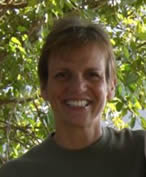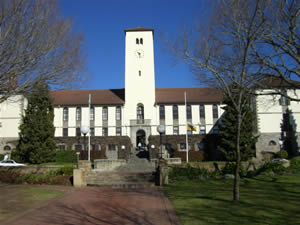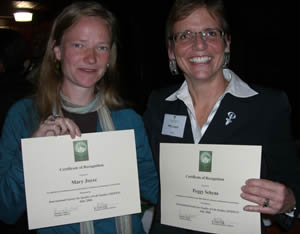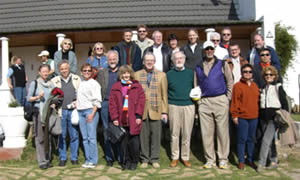|
|
A Visit
Back in Time
...and
a Look to the Future
Join Professor Mary Joyce as she travels to the ever-changing
country of South Africa
Link to Travel Photos
Mary Joyce, Gianneschi Professor of Nonprofit Marketing, recently
traveled to Grahamstown, South Africa, as a participant in the seventh
conference of the International Society for Quality-of-Life Studies.
Here, she reflects on the differences that have happened in that country
since her first visit 12 years ago.
My first visit to South Africa occurred in 1994, a half-year after
apartheid ended. My husband and I were invited to teach a retailing
seminar at the University of Cape Town’s School of Business.
We flew into Johannesburg Airport, which at the time was the Jan Smut
Airport. It was heavily policed, and as we disembarked, we noticed
lots of broken glass and learned that a bomb had gone off just before
our plane landed.
We quickly
caught a flight to Cape Town, and were met by faculty members who escorted
us to the School of Business, a separate building from the main campus further
south. Our school was a former prison that had been converted, and we stayed
at the hotel that was connected to the college. The college was surrounded
by fences with barbed wire and broken glass to discourage crime. This architecture
seemed to contradict the posh, Victoria Wharf shopping center, its neighbor.
Despite
the military presence, and tight security, the spirit in 1994 was quite
high, as the end of apartheid had many individuals hopeful about the new rainbow
nation. Nelson Mandela carefully guided this nation toward peace, freedom
and equality. His leadership was undeniable.
When we
were invited to teach again in 1995, we saw tremendous changes that
could be attributed to this leadership. For example, in one year Mandela had
pushed for changes such as nonsmoking public spaces, equal rights for women
and historically disadvantaged South Africans, and infrastructure changes (e.g.,
electricity, water, education and transportation). His hope was for a redistribution
of wealth and an improved economic growth that would fuel employment growth
and opportunities for all South Africans, but particularly black South Africans.
My husband
and I visited the squatter camp, Khayelitsha, and the township of Guguletu
to learn more about the entrepreneurs of Cape Town. These individuals
had risked a great deal to operate spaza shops (spaza means camouflage).
These shops
were ship containers that were filled with various products that people
in the squatter camps and townships needed, and they were moved to various
locations and identified by a Coca-Cola sign. Black South Africans were not
able to own their own businesses legitimately, so they chose to serve their
communities with these underground operations.
Shabeens,
the equivalent of neighborhood pubs, also provided residents under
apartheid a place to hang out and watch television. By 1995, these entrepreneurs
owned their mini-markets and were legitimate businesspeople. Of course, they
complained about government taxation, which seems to be a universal business
complaint.
Flash forward
to now . . . South Africa’s environment is less militaristic
(particularly Johannesburg) and there has been a redistribution of
wealth. A black South African middle class is growing in size, but
unemployment, AIDS, crime and illiteracy continue to trouble the nation.
John Kane-Berman[editor-in-chief of the South African Survey and Fast Facts,
published by the South Africa Institute of Race Relations], a keynote
speaker at the International Society of Quality of Life Studies (ISQOLS)
conference at Rhodes University, indicated that South Africa’s
efforts to empower black South Africans has been slow and the workforce
is still not representative of the demographics in the area.
The informal
sector continues to foster the greatest growth in South Africa, and
the formal economy has grown in the area of services (e.g., financial, and
retailing). South Africa has lost mining and manufacturing jobs to Asia, particularly
China, and they would like to remedy this.
Unemployment,
according to Kane-Berman, continues to be a huge problem with 4.5 to 8 million
unemployed, depending on the definition of poverty used. When the “discouraged” are
included (i.e., those who are unemployed, but not looking for work),
the higher number is used.
From 1995
to 2005, black South Africans have had less formal housing, more electricity
for lighting, less access to water in their dwellings and yards, less
flush/chemical lavatories, more access to refuse removal, more access to television
and dramatically increased access to telephones, particularly cell phones.
The ISQOLS
conference addressed many of the issues described above since the theme
was quality of life in developing countries. We heard some very good presentations
on such issues.
MLJ
Rhodes University
Zulu dancers who entertained the conference
attendees in Nelson Mandela Hall at Rhodes University.
Mary Joyce at the recognition awards with Peggy Schyns, left, from
the University of Leiden in the Netherlands
ISQOLS group at Amakhala, a private game reserve. Amakhara means “land
of many aloes"
A drink list from a restaurant in Victoria Falls (one $US = 100,000
Zimbabwe $)
Sunset on the Zambezi River in Victoria
Falls
Mary Joyce and Victoria Falls guide Richard
Siyabanda
Victoria
Falls
|










 Produced by the Office of Public Affairs at California State University, Fullerton.
Contact the
Produced by the Office of Public Affairs at California State University, Fullerton.
Contact the